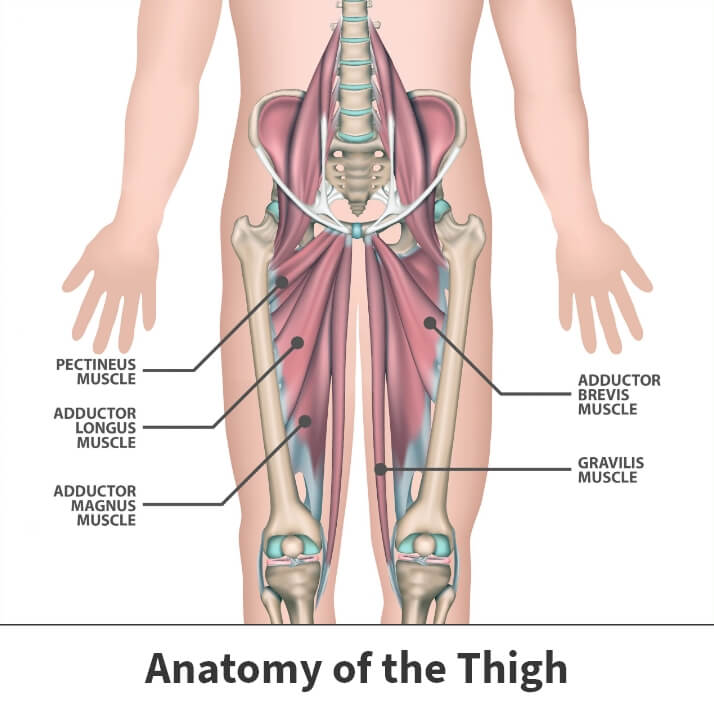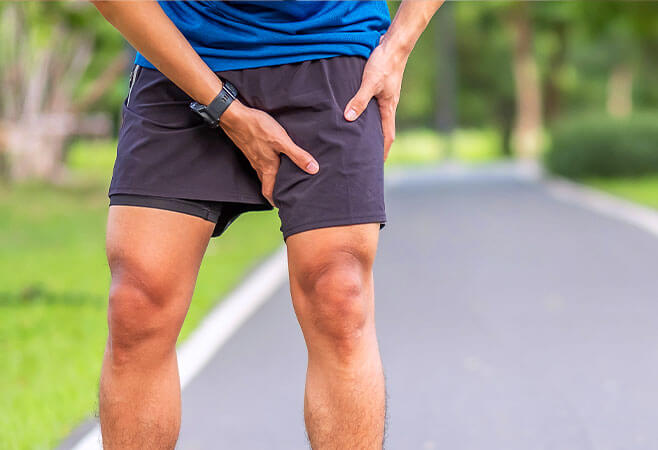Anatomy

The groin region is a collection of six muscles known as the abductor muscles. Located in the inner thigh, these muscles begin in the pelvis and extend to the thigh bone’s inner regions. Healthy groin muscles are vital to your legs and hip joint’s ability to function properly.
About
A groin pull, which is scientifically referred to as a groin strain, occurs when the affected groin muscle or muscles become overstretched. Mild to moderate strains result in slight muscle extensions and minor injuries. A more serious groin pull will often cause muscle features known as fibers to tear. In the most severe cases, groin muscles tear completely.
A groin pull is placed into one of three categories – Grade 1, Grade 2, and Grade 3.
- Grade 1 – This least serious event usually results in the slight overextending of groin muscles.
- Grade 2 – This type of groin strain typically involves a certain degree of tissue damage.
- Grade 3 – These most severe occurrences happen when the affected groin muscles tear significantly or, in some cases, entirely.
Causes
In many instances, a groin strain will result from any movements or activities that place excessive force on the associated muscles.
Risk factors
Athletes often are at an increased risk of developing these injuries. This is because athletes often place sudden and significant stress on the groin muscles.
Your chances of developing a groin pull increase if you participate in an activity requiring increased amounts of running and jumping. A notable percentage of these injuries are seen in people competing in:
- Soccer
- Football
- Basketball
- Ice hockey
A groin strain can also occur following acute events like automobile accidents or falls.

Symptoms
The symptoms you experience will likely depend on your injury’s severity.
- Grade 1 – Groin strain is often only mildly painful and does not usually result in any mobility concerns.
- Grade 2 – Occurrences typically cause more discomfort, can cause redness and swelling, and could lead to mobility problems.
- Grade 3 – Groin pull causes noticeable to severe pain, inflammation, and mobility struggles. Occasionally, you might even have trouble walking. Additionally, serious injuries may result in more intense discomfort during the evening hours and while sitting or resting.
Complications
If left untreated, a groin strain can worsen. The most severe cases could eventually lead to a full-blown muscle rupture, which causes intense pain, significant mobility problems, and often requires surgery to fix.
Diagnosis
A groin strain is not usually difficult for your doctor to identify. Groin pull symptoms are often like other injuries and illnesses, such as:
- Sports hernias
- Pubic bone inflammation
- Pinched nerves
- Lower back injuries
- Arthritis
Besides a comprehensive physical examination, your doctor might order imaging tests such as magnetic resonance imaging scans and X-rays to rule out other conditions.
Treatment
The treatment your doctor prescribes will depend on several factors, including the injury’s severity, your symptoms, your age, and your activity level. A low-grade groin strain often heals with little more therapy than rest. More severe events will need more aggressive treatment and, quite possibly, surgery.
Nonsurgical treatments
For simple Grade 1 strains, rest is usually the best treatment. Besides avoiding any unnecessary movement and temporarily suspending your participation in athletic activities, you may find relief by applying ice to your inner thigh region, compressing the groin using tape or some other movement-restricting material, and using over-the-counter pain and inflammation-alleviating drugs.
You might also speed up the healing process by performing various stretching exercises. These efforts often ease associated pain and are believed to strengthen the groin muscles, which may prevent future recurrences.
Surgical treatments
Only the most serious strains need surgery. Operations are typically performed when you experienced a severe or total muscle tear. Surgical repair will often be followed by a period of physical therapy.
Many physicians stress that surgery is a last resort. Occasionally, surgically repaired groin muscles are not capable of withstanding intense physical activity.
If you are an athlete, such circumstances might prevent you from returning to the sports you enjoy. Weigh all possible options with your doctor before undergoing any operative procedure.
Prevention
Prevention is not always possible. You may decrease your risk by:
- Stretching your leg and groin muscles before participating in moderate to intense athletic activities.
- Immediately stop exercising or competing if you notice any sudden or gradually developing discomfort in your groin area.
- Exercise using comfortable and well-fitting footwear.
- Gradually increase the intensity of your workouts and avoid doing too much too fast.
Above all, you should always use stretching exercises geared towards loosening groin muscles before any activity. This is especially important if you had a previous groin strain.
Prognosis
It is difficult to pinpoint exactly how long your recovery period will be. Naturally, this will depend on how bad the injury is, your general health, physical condition, and the form of treatment applied, as everyone heals at their own specific pace.
Physicians agree that you must be cautious. Rushing back into intense activity could either worsen an existing injury or cause such problems to reappear over time.
Related specialties
- Anterior Hip Replacement
- Avascular Necrosis (Osteonecrosis)
- Hamstring Injuries
- Hip Arthroplasty
- Hip Arthroscopy
- Hip Dislocation
- Hip Flexor Strains
- Hip Fractures
- Hip Hemiarthroplasty
- Hip Impingement Labral Tears
- Hip Muscle Strains
- Hip Pointers & Trochanteric Bursitis
- Iliopsoas Tenotomy
- Labral Tears of the Hip (Acetabular Labrum Tears)
- Osteoarthritis of the Hip
- Osteoporosis
- Pelvic Ring Fractures
- Piriformis Syndrome
- Sports Hernias (Athletic Pubalgia)
- Thigh Fractures
- Thigh Muscle Strains
